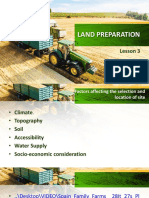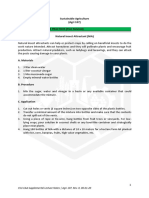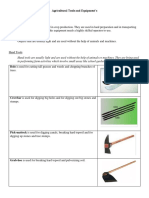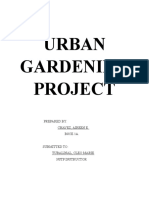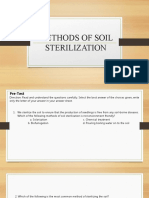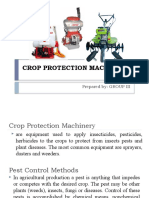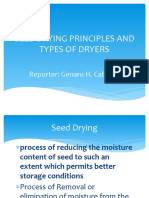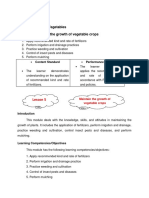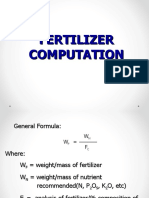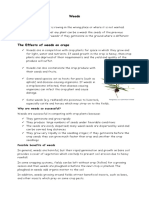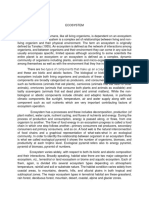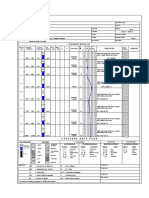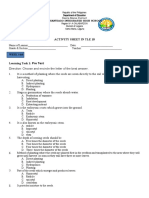Land Preparation Methods
Land Preparation Methods
Uploaded by
Daniel DowdingCopyright:
Available Formats
Land Preparation Methods
Land Preparation Methods
Uploaded by
Daniel DowdingOriginal Description:
Original Title
Copyright
Available Formats
Share this document
Read this document in other languages
Did you find this document useful?
Is this content inappropriate?
Report this DocumentCopyright:
Available Formats
Land Preparation Methods
Land Preparation Methods
Uploaded by
Daniel DowdingCopyright:
Available Formats
Land preparation methods
What is land preparation?
It ensures that the soil is well prepared before a crop is planted. It involves
selecting an appropriate site for a crop and selecting the most appropriate crop
for the land available.
Land preparation involves:
1. Site selection- selecting a location that requires inputs to prepare the land
for planting will cost the farmer money and time. Understanding the best
location for each crop, or adjusting the cropping decision based on the land
available will help the farmer to create a more efficient and profitable farm
business
2. Land clearing- clearing the land is normally the first operation. Depending
on what the land was previously used for, it usually involves removing trees,
bushes, shrubs, tall grasses and crop residues usually with a bulldozer or
cutlass.
Follow this sequence when clearing land:
⮚ Remove trees and heap them in windrows
⮚ Scrape off the top soil and place it into
heaps
⮚ Grade the land, filling in any depressions
⮚ Spread topsoil over the entire area
3. Tillage- refers to the breaking up of the soil
surface and incorporating organic matter into the soil. It
is usually divided into two stages:
⮚ Primary tillage: land that has been cleared is either
dug manually with a garden fork or ploughed
mechanically using a tractor. The effect of primary
tillage is to loosen up the soil surface, allow air and
water to enter the soil more freely, and bury and mix
organic matter with the soil.
At the end of primary tillage, the soil is in large lumps or clods.
⮚ Secondary tillage: refers to breaking
up the large clods of soil into smaller
pieces. This may be done manually
using a hoe, rake or hand fork or
mechanically using a harrow or a
rotovator. The effect of secondary
tillage is to obtain tilt suited to the
crop, produce a seedbed for the cultivation of crops, cut
up and mix organic matter, and allow roots of crops to
penetrate easily and grow freely in the soil.
4. Drainage- farmers must set up drainage to remove excess
water from the surface and sub-surface of the soil,
especially during the rainy season. Drains may be prepared
manually using fork, spade, hoe, rake and garden line or
they can be dug manually using a ridger/ banker or a
backhoe.
5. Leveling and making beds- after the drains have been dug, the land needs
to be levelled to form beds suited to the crop, soil type, season and weather
conditions. During the dry season, flat-topped
beds may be used. In the wet season, the beds
need to be constructed so that excess water
is removed, especially in areas with clay soil.
You might also like
- E.D.P.M AnswersDocument3 pagesE.D.P.M AnswersDaniel Dowding75% (4)
- Land PreparationDocument14 pagesLand PreparationVincent Jay Maat100% (2)
- Common Farm EquipmentDocument5 pagesCommon Farm EquipmentZab80% (5)
- 18 Natural Insect AttractantDocument1 page18 Natural Insect AttractantCute Guardian AngelNo ratings yet
- Heat Treatment Processes Powerpoint PresentationDocument14 pagesHeat Treatment Processes Powerpoint PresentationDaniel Dowding100% (1)
- Care & MaintenanceDocument33 pagesCare & MaintenanceShaiannah Veylaine Recinto Apostol100% (3)
- Agricultural Tools and EquipmentDocument4 pagesAgricultural Tools and EquipmentYvette Galang100% (3)
- Farm Tool 2015Document3 pagesFarm Tool 2015BongTizonDiazNo ratings yet
- Module 6 Land Preparation PresentationDocument26 pagesModule 6 Land Preparation PresentationMyla Solas100% (1)
- Agricultural Crop Production Ncii Evaluation Test For RPLDocument4 pagesAgricultural Crop Production Ncii Evaluation Test For RPLJeniffer Lacambra Dugay100% (4)
- BackyardGardening (NSTP Project)Document66 pagesBackyardGardening (NSTP Project)Aireen Chavez100% (4)
- Landscape Ecology For Sustainable Environment and Culture by Bojie Fu, Bruce Jones K PDFDocument368 pagesLandscape Ecology For Sustainable Environment and Culture by Bojie Fu, Bruce Jones K PDFAaron Arizpe0% (1)
- PREPARE LAND PREPARATIONvegetables GardenDocument52 pagesPREPARE LAND PREPARATIONvegetables GardenRayge HarbskyNo ratings yet
- MODULE 1 Land PreparationDocument8 pagesMODULE 1 Land Preparationariolamarygrace08No ratings yet
- Conduct Land Preparation According To Crop Requirement: Learning Activity SheetDocument6 pagesConduct Land Preparation According To Crop Requirement: Learning Activity SheetEleanor CabungcagNo ratings yet
- Methods of Fertilizer ApplicationDocument19 pagesMethods of Fertilizer ApplicationVerna Aguilar AnieteNo ratings yet
- Prepare The Growing Media and Sow SeedsDocument24 pagesPrepare The Growing Media and Sow SeedsCasey Pheb C. RomezNo ratings yet
- Ragdoll MethodDocument10 pagesRagdoll MethodRon EncinasNo ratings yet
- CpSci 101 - Module 7 - Lesson 5 - Crop Management Practices - Specialized Management PracticesDocument14 pagesCpSci 101 - Module 7 - Lesson 5 - Crop Management Practices - Specialized Management Practicesiris Ω100% (1)
- Site Characterization and SelectionDocument29 pagesSite Characterization and Selectionsamuel pineda100% (1)
- Transplanting of SeedlingsDocument20 pagesTransplanting of SeedlingsMarycon NacitoNo ratings yet
- Seed GerminationDocument8 pagesSeed GerminationDM RielNo ratings yet
- Q1 Module 2. Prepare Land PreparationDocument38 pagesQ1 Module 2. Prepare Land PreparationMitch Panganiban TogniNo ratings yet
- Land PreparationDocument2 pagesLand PreparationDiana Daina80% (5)
- Y4 - Module 6 - Performing Post-Harvest OperationsDocument11 pagesY4 - Module 6 - Performing Post-Harvest OperationsKevin Bermudez AtienzaNo ratings yet
- Direct Seeding and TransplantingDocument3 pagesDirect Seeding and TransplantingDycereel DyrenNo ratings yet
- GR 9 Preparing The Growing Media and Sow SeedsDocument17 pagesGR 9 Preparing The Growing Media and Sow SeedsRowena Sardoma Platilla67% (3)
- Unit of Competency: Agricultural Crop Production NciiDocument11 pagesUnit of Competency: Agricultural Crop Production NciiRoel Bautista100% (2)
- Perform Nursery OperationsDocument71 pagesPerform Nursery OperationsAllen Jade Pateña100% (2)
- Bush Sitao ProductionDocument8 pagesBush Sitao Productionpandaypira100% (1)
- Farm EquipmentsDocument8 pagesFarm EquipmentsJoey Ramirez Marasigan100% (2)
- Module 4. Direct Planting and TransplantingDocument26 pagesModule 4. Direct Planting and TransplantingMayco CabildoNo ratings yet
- Learner'S Home Task in Technology and Livelihood EducationDocument6 pagesLearner'S Home Task in Technology and Livelihood EducationRonald Matias CristobalNo ratings yet
- Methods of Soil SterilizationDocument38 pagesMethods of Soil SterilizationArianneNo ratings yet
- Chapter 3 - Farm Tools, Equipment, Inputs AND LABORDocument5 pagesChapter 3 - Farm Tools, Equipment, Inputs AND LABOREly gy100% (3)
- Horticulture Lesson1 - Tools and EquipmentDocument31 pagesHorticulture Lesson1 - Tools and EquipmentMaRemalyneCruz100% (4)
- Tle 10 2021 2022Document12 pagesTle 10 2021 2022Almira Mendez100% (1)
- Crop Protection MachineryDocument50 pagesCrop Protection MachineryArman RiveraNo ratings yet
- Agri Crop Nine ThreeDocument4 pagesAgri Crop Nine ThreeRhylyahnaraRhon Palla PeraltaNo ratings yet
- MOETDocument9 pagesMOETRia Mae Espenida GurayNo ratings yet
- Seed Drying Principles and Types of DryersDocument21 pagesSeed Drying Principles and Types of DryersŇel DanNo ratings yet
- Agri Module 3 LC BasedDocument18 pagesAgri Module 3 LC BasedJean Caloy Falucho100% (1)
- Bolo Is Used For Cutting Tall Grasses and Weeds and Chopping Branches of TreesDocument11 pagesBolo Is Used For Cutting Tall Grasses and Weeds and Chopping Branches of TreesMargie Ballesteros Manzano0% (1)
- Module 5. (59pp) Maintain The Growth of CropsDocument59 pagesModule 5. (59pp) Maintain The Growth of CropsDimasalang Perez50% (2)
- Tools in Agricultural Crops ProductionDocument12 pagesTools in Agricultural Crops ProductionCami Lyn LigmayoNo ratings yet
- Fetilizer ComputationDocument10 pagesFetilizer ComputationAliah CanalsNo ratings yet
- CH.2 Branches of AgricultureDocument6 pagesCH.2 Branches of Agriculturetanuj100% (1)
- Land Preparation and Planting PracticesDocument17 pagesLand Preparation and Planting PracticesQuinnee Vallejos86% (7)
- TLE 10 Agri Crop Prod Q2 Module 4 Week 4Document4 pagesTLE 10 Agri Crop Prod Q2 Module 4 Week 4Jess Anthony Efondo100% (3)
- MARTIN H. BUTAC Narrative Report (MOET)Document12 pagesMARTIN H. BUTAC Narrative Report (MOET)Rovieda ButacNo ratings yet
- Rice TransplanterDocument12 pagesRice TransplanterUnodos100% (1)
- TLE 8 Lesson 2Document15 pagesTLE 8 Lesson 2LeoAtienzaNo ratings yet
- Module 5. Maintain The Growth of CropsDocument98 pagesModule 5. Maintain The Growth of CropsMayco CabildoNo ratings yet
- Sdo Aurora Tle10 Afa-Acp q4 m3Document13 pagesSdo Aurora Tle10 Afa-Acp q4 m3miel park100% (1)
- Horticulture 10 Week5Document10 pagesHorticulture 10 Week5jf2ralbaNo ratings yet
- UC3-Core-Caring-and-maintaining-crops WORDDocument126 pagesUC3-Core-Caring-and-maintaining-crops WORDEdith BasubasNo ratings yet
- Module 4. (14pp) Direct Planting and TransplantingDocument14 pagesModule 4. (14pp) Direct Planting and TransplantingDimasalang Perez88% (8)
- Farm Implements IMAGEDocument2 pagesFarm Implements IMAGEJunior FelipzNo ratings yet
- Rmo Common 2Document29 pagesRmo Common 2Valcy Madz100% (1)
- G11 LAS in ACP Q2Wk5 Apply Basal Fertilizer Based On Crop RequirementDocument6 pagesG11 LAS in ACP Q2Wk5 Apply Basal Fertilizer Based On Crop RequirementEleanor CabungcagNo ratings yet
- Organic Agriculture: Module 4: - Prepare Composting Area and Raw Materials Quarter 1, Week 4 Aussie Charity T. CaliboDocument16 pagesOrganic Agriculture: Module 4: - Prepare Composting Area and Raw Materials Quarter 1, Week 4 Aussie Charity T. CaliboDianne Abante100% (1)
- Fact Sheet 2. Land Preparation and Planting PracticesDocument7 pagesFact Sheet 2. Land Preparation and Planting PracticesJake Ruzzel Tibon PilloNo ratings yet
- 2 Plant CropsDocument46 pages2 Plant CropsRyan Paul CaalemNo ratings yet
- AGR X101 Lec.4Document4 pagesAGR X101 Lec.4wokep20470No ratings yet
- Cropping Systems: What Is A Cropping System?Document4 pagesCropping Systems: What Is A Cropping System?Daniel DowdingNo ratings yet
- MitosisDocument2 pagesMitosisDaniel DowdingNo ratings yet
- The Importance of Plant QuarantineDocument1 pageThe Importance of Plant QuarantineDaniel DowdingNo ratings yet
- Machinery in Crop HusbandryDocument6 pagesMachinery in Crop HusbandryDaniel DowdingNo ratings yet
- Sowing Seeds and Seedling ProductionDocument2 pagesSowing Seeds and Seedling ProductionDaniel DowdingNo ratings yet
- Plant Processes: 1. PhotosynthesisDocument2 pagesPlant Processes: 1. PhotosynthesisDaniel Dowding100% (1)
- The Principals of Genetic Inheritance: Cells Tissues Organs BodyDocument2 pagesThe Principals of Genetic Inheritance: Cells Tissues Organs BodyDaniel DowdingNo ratings yet
- Weeds What Is A Weed?: Why Are Weeds So Successful?Document3 pagesWeeds What Is A Weed?: Why Are Weeds So Successful?Daniel Dowding100% (1)
- Roles and Careers in AgricultureDocument3 pagesRoles and Careers in AgricultureDaniel DowdingNo ratings yet
- Non-Conventional Farming Cont'dDocument3 pagesNon-Conventional Farming Cont'dDaniel DowdingNo ratings yet
- Section B-Introduction To Crop ProductionDocument3 pagesSection B-Introduction To Crop ProductionDaniel DowdingNo ratings yet
- Challenges in AgricultureDocument5 pagesChallenges in AgricultureDaniel DowdingNo ratings yet
- What Is Organic Farming?Document2 pagesWhat Is Organic Farming?Daniel DowdingNo ratings yet
- What Is Asexual Reproduction?Document5 pagesWhat Is Asexual Reproduction?Daniel DowdingNo ratings yet
- Vershanie Goberdhan SBA (CROP)Document39 pagesVershanie Goberdhan SBA (CROP)Daniel DowdingNo ratings yet
- Fruit CropDocument8 pagesFruit CropDaniel DowdingNo ratings yet
- (Kelly Sankar) Business PlanDocument17 pages(Kelly Sankar) Business PlanDaniel DowdingNo ratings yet
- Anna Regina Secondary School School Based Assessment (2020-2022) EnglishDocument17 pagesAnna Regina Secondary School School Based Assessment (2020-2022) EnglishDaniel DowdingNo ratings yet
- Classical Antiquity (In Which The Sport Was Largely Greco-Roman Influenced) New Track andDocument6 pagesClassical Antiquity (In Which The Sport Was Largely Greco-Roman Influenced) New Track andDaniel DowdingNo ratings yet
- Liturature ReviewDocument2 pagesLiturature ReviewDaniel DowdingNo ratings yet
- Cyril Potter College of Education: EssayDocument4 pagesCyril Potter College of Education: EssayDaniel DowdingNo ratings yet
- English A&B Sba Mark Scheme: Areas Marks Assigne D Marks CommentsDocument2 pagesEnglish A&B Sba Mark Scheme: Areas Marks Assigne D Marks CommentsDaniel Dowding100% (1)
- Duncans Realty & Property Management Services Employee Time SheetDocument2 pagesDuncans Realty & Property Management Services Employee Time SheetDaniel DowdingNo ratings yet
- Agricultural Science Assignment On Fruit, Root and Leafy CropsDocument4 pagesAgricultural Science Assignment On Fruit, Root and Leafy CropsDaniel DowdingNo ratings yet
- E.D.P.M PracticeDocument3 pagesE.D.P.M PracticeDaniel DowdingNo ratings yet
- S5FE IVg 7Document11 pagesS5FE IVg 7Bernadith Magada Roco-SamonteNo ratings yet
- Session 21 - 22 Group Piles: Course: MKB 41645/foundation Engineering Year: 2015Document25 pagesSession 21 - 22 Group Piles: Course: MKB 41645/foundation Engineering Year: 2015Mardha TillahNo ratings yet
- Romantic Art and NEOCLASSICISM and ROMANTICISM in The PhilippinesDocument43 pagesRomantic Art and NEOCLASSICISM and ROMANTICISM in The PhilippinesPrincess Mae CoronoNo ratings yet
- Msand in TamilnaduDocument15 pagesMsand in Tamilnadumadhan kumar100% (5)
- Physical Map of India, India Physical MapDocument2 pagesPhysical Map of India, India Physical MapVishnu PrasadNo ratings yet
- Whose Landscape Is It Remapping Memory and History in Interwar Central EuropeDocument26 pagesWhose Landscape Is It Remapping Memory and History in Interwar Central EuropeCuerpos InsanosNo ratings yet
- Soil Mechanics I April 16, 2011Document2 pagesSoil Mechanics I April 16, 2011Kebede kasaNo ratings yet
- Summative Test No. 1 Modules 1-2 4 Quarter: Science 5Document3 pagesSummative Test No. 1 Modules 1-2 4 Quarter: Science 5Maryflor MoratoNo ratings yet
- Spatium 25Document72 pagesSpatium 25Hotel ObrenovacNo ratings yet
- Universiti Tun Hussein Onn MalaysiaDocument15 pagesUniversiti Tun Hussein Onn MalaysiaFatin Nadia DieyaNo ratings yet
- Laboratorium Mekanika Tanah Fakultas Teknik Universitas Syiah Kuala Cone Penetration TestDocument5 pagesLaboratorium Mekanika Tanah Fakultas Teknik Universitas Syiah Kuala Cone Penetration TestmustakimNo ratings yet
- Lebanese Architecture PDFDocument9 pagesLebanese Architecture PDFaboudehNo ratings yet
- EcosystemDocument3 pagesEcosystemBenmark JabayNo ratings yet
- Hume Pipe Culverts EstimateDocument6 pagesHume Pipe Culverts EstimateChandu NaniNo ratings yet
- Cypripedium - Lady Slipper Orchids For The GardenDocument9 pagesCypripedium - Lady Slipper Orchids For The GardenDennis CareyNo ratings yet
- Indian Cultural Landscapes - Religious Pluralism, Tolerance and Ground Reality - Architexturez South AsiaDocument9 pagesIndian Cultural Landscapes - Religious Pluralism, Tolerance and Ground Reality - Architexturez South AsiaTanushree Roy PaulNo ratings yet
- Say ReportDocument13 pagesSay ReportFakhriyah SaidNo ratings yet
- Soil Resources in IndiaDocument8 pagesSoil Resources in IndiaAriba Hurrain HussainNo ratings yet
- Grade 07 Geography 3rd Term Test Paper 2019 English Medium - Central ProvinceDocument5 pagesGrade 07 Geography 3rd Term Test Paper 2019 English Medium - Central ProvinceAsma100% (2)
- Class-Ix: Geography Assignment - 2 TOPIC - Physical FeaturesDocument2 pagesClass-Ix: Geography Assignment - 2 TOPIC - Physical Featuressaipranav chinthakuntaNo ratings yet
- Background of The Study and Definition of TermsDocument4 pagesBackground of The Study and Definition of TermsErnest MiapeNo ratings yet
- Preliminary Boring Log: Clays, Lowly Plastic, Very MoistDocument1 pagePreliminary Boring Log: Clays, Lowly Plastic, Very MoistVicky MunienNo ratings yet
- Case Study of Duzce University Campus Design, TurkeyDocument1 pageCase Study of Duzce University Campus Design, TurkeyAbdullah AlnagarNo ratings yet
- Dig It Rocks Soil WorkbookDocument25 pagesDig It Rocks Soil Workbooknia rahmayantiNo ratings yet
- Activity Sheet in Tle 10: WEEK 5&6Document3 pagesActivity Sheet in Tle 10: WEEK 5&6Mariel Lopez - MadrideoNo ratings yet
- Geo102 Part18 Glaciers BLP 2020Document63 pagesGeo102 Part18 Glaciers BLP 2020HarryStrikesNo ratings yet
- Lecture 1 - Introduction and Landslide ClassificationDocument41 pagesLecture 1 - Introduction and Landslide ClassificationYUK LAM WONGNo ratings yet
- Raunkiers Life FormsDocument11 pagesRaunkiers Life FormsEunice SantiagoNo ratings yet

